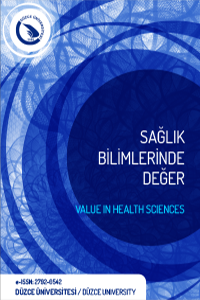Fokal Asimetrik Meme Dansitelerinin Değerlendirilmesinde Tomosentezin Tanıya Katkısı
Dijital mamografi, Tomosentez, Fokal asimetrik dansite
Contribution of Tomosynthesis on the Evaluation of Focal Asymmetrical Breast Densities
Digital mammography, Tomosynthesis, Focal asimetrical density,
___
- Breast Cancer [Internet]. 2021. Available from: https://www.who.int/news-room/fact-sheets/detail/breast-cancer
- Menhas R, Umer S. Breast Cancer among Pakistani Women. Iran J Public Health. 2015; 44(4): 586-7.
- Joseph S, Singh E. Nuclear Medicine PET/CT Breast Cancer Assessment, Protocols, And Interpretation. In Treasure Island (FL); 2022.
- Waheed H, Masroor I, Afzal S, Alvi MI, Jahanzeb S. Digital breast tomosynthesis versus additional diagnostic mammographic views for the evaluation of asymmetric mammographic densities. Cureus. 2020; 12(8): e9637.
- Kiarashi N, Samei E. Digital breast tomosynthesis: A concise overview. Imaging Med. 2013; 5(5): 467-76.
- Radiology AC of, D’Orsi CJ. ACR BI-RADS Atlas: Breast ımaging reporting and data system: 2013. American College of Radiology; 2018.
- Chesebro AL, Winkler NS, Birdwell RL, Giess CS. Developing asymmetry at mammography: Correlation with US and MR ımaging and histopathologic findings. Radiology. 2016; 279(2): 385-94.
- Andersson I, Ikeda DM, Zackrisson S, Ruschin M, Svahn T, Timberg P, et al. Breast tomosynthesis and digital mammography: a comparison of breast cancer visibility and BIRADS classification in a population of cancers with subtle mammographic findings. Eur Radiol. 2008;18(12):2817–25. https://doi.org/10.1007/s00330-008-1076-9
- Teertstra HJ, Loo CE, van den Bosch MAAJ, van Tinteren H, Rutgers EJT, Muller SH, et al. Breast tomosynthesis in clinical practice: initial results. Eur Radiol. 2010; 20(1): 16-24.
- Chesebro AL, Winkler NS, Birdwell RL, Giess CS. Developing asymmetries at mammography: A multimodality approach to assessment and management. radiographic. 2016; 36(2): 322-34. https://doi.org/10.1148/rg.2016150123
- Chong A, Weinstein SP, McDonald ES, Conant EF. Digital breast tomosynthesis: concepts and clinical practice. Radiology. 2019; 292(1): 1-14.
- Seo N, Kim HH, Shin HJ, Cha JH, Kim H, Moon JH, et al. Digital breast tomosynthesis versus full-field digital mammography: comparison of the accuracy of lesion measurement and characterization using specimens. Acta Radiol. 2014; 55(6): 661-7.
- Zuley ML, Bandos AI, Ganott MA, Sumkin JH, Kelly AE, Catullo VJ, et al. Digital breast tomosynthesis versus supplemental diagnostic mammographic views for evaluation of noncalcified breast lesions. Radiology. 2013; 266(1): 89-95.
- Yamamoto N, Yoshizako T, Yoshida R, Ando S, Nakamura M, Yoshikawa K, et al. Usefulness of digital breast tomosynthesis for non-calcified benign breast masses. Clin Imaging. 2019; 54: 84-90.
- Lee AHS. Why is carcinoma of the breast more frequent in the upper outer quadrant? A case series based on needle core biopsy diagnoses. Breast. 2005; 14(2): 151-2.
- Chan S, Chen J-H, Li S, Chang R, Yeh D-C, Chang R-F, et al. Evaluation of the association between quantitative mammographic density and breast cancer occurred in different quadrants. BMC Cancer. 2017; 17(1): 274. https://doi.org/10.1186/s12885-017-3270-0
- Seo M, Chang JM, Kim SA, Kim WH, Lim JH, Lee SH, et al. Addition of digital breast tomosynthesis to full-field digital mammography in the diagnostic setting: Additional value and cancer detectability. J Breast Cancer. 2016; 19(4): 438-46.
- Cho KR, Seo BK, Kim CH, Whang KW, Kim YH, Kim BH, et al. Non-calcified ductal carcinoma in situ: ultrasound and mammographic findings correlated with histological findings. Yonsei Med J. 2008; 49(1): 103-10.
- Skaane P. Breast cancer screening with digital breast tomosynthesis. Breast Cancer. 2017; 24(1): 32-41.
- Yayın Aralığı: Yılda 3 Sayı
- Başlangıç: 2022
- Yayıncı: Düzce Üniversitesi
Kolorektal Kanser Hücrelerinde Boraksın Gpx4/ACSL4 Sinyal Yolu Aracılığıyla Sitotoksik Etkileri
Fatma BEYAZAL ÇELİKER, Levent TÜMKAYA, Tolga MERCANTEPE, Mehmet BEYAZAL, Arzu TURAN, Gülen BURAKGAZİ, Nur HÜRSOY
COVID-19 Pandemisi: Uzaktan Eğitimin Sağlık Alanında Eğitim Gören Öğrenciler Üzerindeki Etkileri
Aslıhan ŞAYLAN, Omur DENİZ, Murat DIRAMALI
Çocuk ve Adolesanlarda Uyku ile İlişkili Solunum Bozuklukları: Diş Hekiminin Rolü
Hakan SOYLU, Kübra AKSU, İsmail ÜSTÜNEL, Kayihan KARACOR, Özge BEYAZÇİÇEK
COVID-19 Pandemisinin İlk Aylarında Kanser Hastalarında Kaygı Düzeyleri
Seher Nazlı KAZAZ, Atila YILDIRIM
Mültecilerde Sağlık Hizmetlerine Erişim
Selma ALTINDİŞ, Mustafa Baran İNCİ, Ünal ERKORKMAZ
COVID-19’a Bağlı Sitokin Fırtınasında Anakinra ve Tosilizumab Tedavilerinin Karşılaştırılması
Ali AKIN, Yılmaz SAFİ, Talat Soner YILMAZ
Helicobacter pylori Eradikasyonunda Kullanılan Kombine Tedavilerin Etkinliklerinin Karşılaştırılması
Adem KOYUNCU, Davut SARI, Gülden SARI, Cebrail ŞİMŞEK, Ünal AKEL
